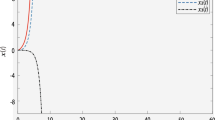Abstract
This paper is concerned with the effects of redundant control inputs on the quadratic optimal performance index in finite-time optimal control. Actually, the effects of redundant control input on quadratic performance index is equal to study the effects of the redundant control input on the solution of Riccati differential equation (RDE). Hence, some sufficient conditions are presented to strictly decrease the solution of RDE with the column of input matrix increased. Especially, a necessary and sufficient condition is derived to strictly decrease the solution of the homogeneous RDE after control input extensions. Moreover, one sufficient condition is obtained, which guarantees that the minimum control energy index strictly decreases with input extension. It is shown that redundant control inputs can improve the system performance based on these results. Some examples are taken to illustrate the effectiveness of related problems.
Similar content being viewed by others
References
Härkegȧrd O and Glad S T, Resolving actuator redundancy-optimal control vs control allocation, Automatica, 2005, 41: 137–144.
Härkegȧrd O, Dynamic control allocation using constrained quadratic programming, Journal of Guidance, Control, and Dynamics, 2004, 27: 1028–1034.
Johansen T A, Fossen T I, and Berge S P, Constrained nonlinear control allocation with singularity avoidance using sequential quadratic programming, IEEE Transactions on Control Systems Technology, 2004, 12: 211–216.
Petersen J and Bodson M, Constrained quadratic programming techniques for control allocation, Conference on decision and control, 2003, 3378–3383.
Kishore W C A, Sen S R G, and Ghoshal T K, Dynamic control allocation for tracking timevarying control demand, Journal of Guidance, Control, and Dynamics, 2008, 31: 1150–1157.
Alwi H and Edwards C, Fault tolerant control using sliding modes with online control allocation, Automatica, 2008, 44: 1859–1866.
Zaccarian L, Dynamic allocation for input redundant control systems, Automatica, 2009, 45: 1431–1438.
Davidson J B, Lallman F J, and Bundick W T, Real-time adaptive control allocation applied to a high performance aircraft, 5th SIAM Conference on Control and Its Application, 2001, 1–11.
Duan Z S, Huang L, and Yang Y, The effects of redundant control inputs in optimal control, Science in China Series F, 2009, 52: 1973–1981.
Duan Z S, Huang L, and Yao Y, On the effects of redundant control inputs, Automatica, 2012, 48: 2168–2174.
Hu S S, Wang Z Q, and Hu W L, The Optimal Control Theory and System, Science Press, Beijing, 2010, 165–172.
Muller P C and Weber H I, Analysis and optmization of certain qualities of controllability and observability for linear dynamical system, Automatica, 1972, 8: 237–246.
Xia Y P, Cai C X, Yin M H, et al., The effects of the distance to uncontrollability in redundant optimal control, The 33rd Chinese Control Conference, 2014, 9016–9021.
Wang W, Ma H, Xia M, et al., Attitude and altitude controller design for quad-rotor type mavs, Mathematical Problems in Engineering, 2013, 2013: 1–9.
Jodar L and Navarro E, Closed analytical solution of riccati type matrix differential equation, Indian Journal Pure Application Mathmatical, 1992, 23: 185–187.
Author information
Authors and Affiliations
Corresponding author
Additional information
This work is supported by the National Natural Science Foundation of China under Grant Nos. 61174038 and 61203129.
This paper was recommended for publication by Editor FENG Gang.
Rights and permissions
About this article
Cite this article
Xia, Y., Cai, C., Yin, M. et al. The effects of redundant control inputs in finite-time optimal control. J Syst Sci Complex 29, 1553–1564 (2016). https://doi.org/10.1007/s11424-016-5069-5
Received:
Revised:
Published:
Issue Date:
DOI: https://doi.org/10.1007/s11424-016-5069-5




